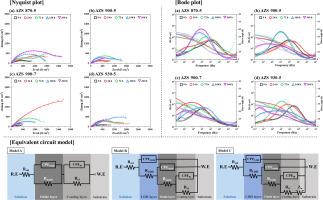ZnAl-LDH对热冲压用Al-Zn-Si涂层耐蚀性的影响
IF 6.3
2区 材料科学
Q2 CHEMISTRY, PHYSICAL
引用次数: 0
摘要
本研究提出了一种通过添加Zn合金来显著提高压硬化钢铝硅保护涂层耐蚀性的方法。制备了以Al为平衡,Zn为20±0.5 wt.%, Si为9.5 wt.%, Zn含量较低的AZS涂层。尽管锌含量不大,但在奥氏体化条件下,它有效地充当了保护基体的牺牲阳极。900℃左右奥氏体化温度±30℃的变化导致涂层内al枝晶相的结构变形,进而影响Al-Zn界面的电偶腐蚀速率。这些差异显著改变了ZnAl-LDH的电化学行为和屏蔽性能,导致涂层的耐腐蚀性发生变化。另外,在900℃下5 min热处理条件的基础上,热处理时间延长2 min, AZS涂层的耐蚀性明显降低。不同热处理条件下耐蚀性能的差异主要归因于ZnAl-LDH在涂层表面的成核生长时间以及CO32-和Cl-等客体阴离子的插入时间。本文章由计算机程序翻译,如有差异,请以英文原文为准。

Effects of ZnAl-LDH on the corrosion resistance of heat-treated Al-Zn-Si coatings with a new elemental composition for hot stamping
This study proposes a method to significantly enhance the corrosion resistance of Al-Si coatings for protecting press hardening steel by alloying them with Zn. The AZS coating containing Al as the balance, 20±0.5 wt.% Zn, 9.5 wt.% Si, was produced with low Zn content. Despite the modest amount of Zn, it effectively served as a sacrificial anode to protect the substrate under austenitization conditions. The ±30 °C variation in austenitizing temperature around 900 °C caused structural deformation of the Al-dendrite phase within the coating, which in turn affected the galvanic corrosion rate at the Al-Zn interface. These differences significantly altered the electrochemical behavior and shielding properties of ZnAl-LDH, resulting in variations in the corrosion resistance of the coating. Additionally, when the heat treatment duration was increased by 2 min based on the 5 min heat treatment condition at 900 °C, the corrosion resistance of the AZS coating significantly decreased. The difference in corrosion resistance characteristics under these heat treatment conditions is attributed to the duration of nucleation growth of ZnAl-LDH on the coating surface and the insertion timing of guest anions such as CO32- and Cl-.
求助全文
通过发布文献求助,成功后即可免费获取论文全文。
去求助
来源期刊

Surfaces and Interfaces
Chemistry-General Chemistry
CiteScore
8.50
自引率
6.50%
发文量
753
审稿时长
35 days
期刊介绍:
The aim of the journal is to provide a respectful outlet for ''sound science'' papers in all research areas on surfaces and interfaces. We define sound science papers as papers that describe new and well-executed research, but that do not necessarily provide brand new insights or are merely a description of research results.
Surfaces and Interfaces publishes research papers in all fields of surface science which may not always find the right home on first submission to our Elsevier sister journals (Applied Surface, Surface and Coatings Technology, Thin Solid Films)
 求助内容:
求助内容: 应助结果提醒方式:
应助结果提醒方式:


